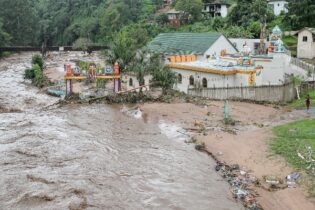Bulk infrastructure is now part of the targets and actions for Vision 2030, which are the guiding principles of the NWRS2, Lerato Mokoena, programme manager: Regional Bulk Infrastructure Programme at the DWA, tells Chantelle van Schalkwyk.
The focus on the roll-out of bulk raw water infrastructure developments has changed significantly in the new National Water Resource Strategy 2 (NWRS2). “Significant emphasis is placed on the principles of Integrated Water Resource Management (IWRM) in the NWRS2. As part of IWRM, bulk infrastructure is highlighted and the strategy also gives considerable emphasis on the establishment of regional water utilities whose main function is bulk infrastructure,” says Mokoena. This needs to be viewed in conjunction with the fact that all regions have significant bulk infrastructure needs, but for different drivers or reasons according to their specific circumstances, according to Mokoena. “In the Western Cape and Northern Cape, for example, the key driver of bulk infrastructure is water scarcity. In Limpopo, Eastern Cape and KwaZulu-Natal, the key driver is to enable the provision of services to households with backlogs in services. Considering all the drivers, the Department of Water Affairs (DWA) estimates that the provinces with the largest water services bulk infrastructure needs are the Eastern Cape, KwaZulu Natal and Limpopo.” Moekena adds that the roll-out of bulk infrastructure projects are specifically addressed in the NWRS2, referring to Annexure A: “Perspectives per Water Management area”, which highlights the specific requirements of bulk infrastructure in more detail, whereas in the past the NWRS mainly focused on the water resources for each water management area. However, she notes that the roll-out of all new bulk projects required is not described in all areas because not only would describing the bulk infrastructure needs in the NWRS2 make the document far too big, “there is still outstanding information on the number of potential options with regards to bulk infrastructure requirements”. Providing clarity In an effort to provide clarity on a broad and expansive topic, Mokoena notes that the Regional Bulk Infrastructure Grant (RBIG) is not limited to bulk raw water infrastructure and includes bulk infrastructure for the provision of water services. This includes small water resources (i.e. small dams), bulk raw water, bulk potable water and effluent sanitation infrastructure. “RBIG, however, does not fund bulk projects for metros and focuses on bulk projects in all the other municipalities,” says Mokoena. That being said, the importance of rolling out of bulk raw water infrastructure developments in order to meet delivery goals cannot be over-emphasised. “Bulk infrastructure is often quoted as the key reason for not meeting delivery goals for water services. Bulk infrastructure, however, does not directly address service delivery, but enables the provision of services by providing water resources and/or connecting the water resources with the reticulation infrastructure. To answer the question directly, bulk water is essential to meeting delivery goals,” she says. The influence is two-fold as well, addressing issues of sustainability at the same time – essentially bulk infrastructure is the key to ensuring the sustainability of water supply. “Through bulk infrastructure, water resources are augmented to meet increasing water demands and to compact the effects of climate changes such as drought. Some of the RBIG projects funded include desalination plants (the Clanwilliam/Lambertsbaai project in the Western Cape, for example) and an effluent recycling plant (George in the Western Cape), the development of small dams (LudekeDam in Greater Mbizanain the Eastern Cape) and the development of boreholes. “The RBIG projects have to be directly linked to the water resources planning and strategy as documented in the water resource reconciliation strategies and all town studies,” explains Mokoena. Planning prioritised Planning, specifically integrated development planning and decision making, thus becomes critical in the roll-out of these and other projects of a similar nature. “Integrated planning and decision making is essential on three key levels.” The first level, according to Mokoena, is theintegration and alignment of the design of the infrastructure throughout the water value chain starting from water resources, bulk infrastructure water reticulation, effluent services, bulk effluent systems and wastewater treatment. “The misalignment of the design of each of these components can lead to significant inefficiencies and can negatively impact on service delivery as well as the environment.” She adds that the second aspect is the planning of the roll-out of these projects and the third is the actual implementation or construction of the projects. Although the timing of the planning of each component may be adequately aligned, often the problem comes in the execution of the various different projects.“Financial constraints or problems and challenges with procurement or the construction can lead to one project been delayed by months and even years while the other project of another component could be completed on schedule. “The misalignment of timing of construction can lead to infrastructure not been commissioned for lengthy periods of time after they are completed or the underutilisation of such infrastructure. The consequences of such misalignment can have significant financial costs whereby the condition of such infrastructure can deteriorate very fast if not operated and maintained.” Mokoena adds that unfortunately there have been a few examples of such misalignment in the past, “but the DWA is placing considerable effort in minimising such incidents from reoccurring in the future by holding regular planning meetings with all stakeholders and industry role players, particularly the municipalities.” Conquering challenges According to Mokoena there are a number of key challenges with the RBIG that the department is facing; however, the DWA has strategies, process and programmes in place to ultimately overcome them. The first challenge is the long procurement and design process of projects. In this regard, the DWA is increasing its own capacity and direct involvement in the implementation of projects and will also be making more use of water boards.“The DWA has also developed ‘term contracts’ for various contract and services, which will avoid additional procurement processes by municipalities and can be used by other government institutions.” With regards to the limited institutional capacity of municipalities, which also has proven challenging in the roll out of similar projects in the past, Mokoena notes that the DWA has taken a decision not to allow the implementation of any RBIG projects by a municipality that is deemed to have a poor track record and limited institutional capacity.An added challenge that is often not addressed in the mainstream media is expectations and planning/design parameters of projects that make service delivery unaffordable. “The DWA is becoming a lot more stringent in planning studies before it approves the funding of projects, placing more emphasis on the sustainability of both the funding and the projects themselves. There is also a need to develop a rural water supply policy that redefines water supply objectives and addresses the many challenges that are specific to rural water supply,” she says.
Challenging contractors A well-documented challenge faced in the roll-out of these mostly large-scale projects is that of non-performing contractors. According to Mokoena, a number of often weak or inexperienced contractors have been appointed in the past for one of three main reasons:- in order to support emerging contractors
- due to political interference
- training of unskilled labour
- providing workers with work experience at a number of levels from highly technical jobs to manual labour
- temporary employment for the duration of construction
- creation of permanent jobs related to the operation and maintenance of the infrastructure
- creation of permanent jobs, from job offers by the contracting companies







